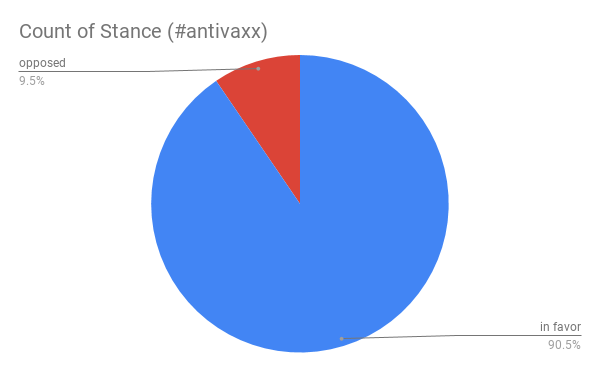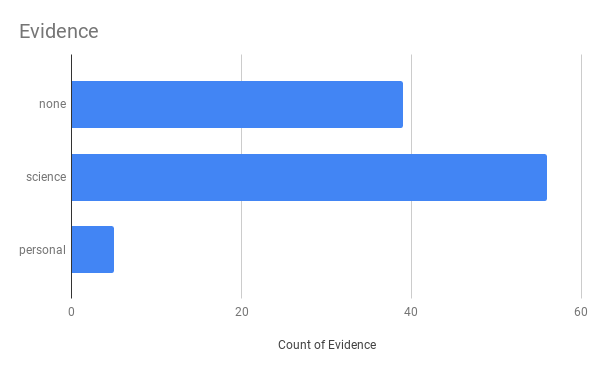Vaccines: Yes or No?
Children, needles, and science (or the lack of).
What do these all have in common? #VaccinesWork and #antivaxx.
For this research, I explored the hashtag #VaccinesWork. My initial capturing of tweets brought in 9,624 with 6,583 of them being unique tweets. In order to narrow these tweets down to a more manageable size, I took out the retweets, removed anything that wasn’t in English, and then narrowed down the time frame to August 24th to August 26th. This left me with about a hundred tweets with the hashtag #VaccinesWork to analyze.
After analyzing these tweets, I decided to also analyze twenty-one tweets with the hashtag #antivaxx. These tweets were narrowed down to the time frame of August 25th to August 26th. I decided to do this in order to get a more complete picture of the discussion going on around vaccines on Twitter.
Going into this assignment I had a lot of assumptions about what I would find. When it came to the hashtag #VaccinesWork, most of my assumptions were right. However, there were a lot of surprises when it came to the hashtag #antivaxx.
Yes or No?

One of the surprises from my research came down to the simple question: vaccines, yes or no? I wasn’t shocked to find out that 93% of the people using the hashtag #VaccinesWork were in favor of vaccines with only 7% being opposed. The hashtag itself leads us to this assumption. However, what is shocking is that out of the twenty-one tweets I looked at for #antivaxx, 90.5% of the tweeters were in favor of the vaccine and only 9.5% were opposed. One thing to keep in mind is the fact that this is a smaller sample size than the other, so it might be a little skewed.

It was only after I took a closer look at who was using the hashtag #antivaxx that the startling number of tweets in favor of vaccines began to make sense. While looking over the usernames of the various tweeters, I noticed that the top tweeter had the word bot in it. After some investigation, I found out that this account is a bot that is run using FTTT. Out of the tweets that I analyzed for #antivaxx 71.4% of them were from this bot account.

Due to this high number of bot tweets, I don't feel comfortable making any observations about the tweets and arguments presented in them. For the rest of this post, I will only be mainly focused on the hashtag #VaccinesWork.
Why do people feel this way?

The rationale behind the hashtag must be looked at somewhat skeptically. When going through the tweets, I had to make assumptions about what was being discussed. Some of them outright stated that the reason for their feelings on vaccines was because of children, which ended up being 20% of the tweets. Others were a bit more ambiguous, and I decided to place them under the label of "public health", which was 53% of the tweets. The rest of the tweets were categorized into "safe" 24%, and "autism" 3%. All of the tweets with the rationale autism were a part of the 7% of tweets that were against vaccines.
On-time vaccination during childhood is essential to provide immunity before children are exposed to life-threatening diseases. #vaccines #vaccinessavelives #vaccineswork #ivax2protect pic.twitter.com/5ubkTuxRER
— Fighting Infectious Diseases in Emerging Countries (@FIDEC_US) August 26, 2019
What evidence are people using?

There were two types of evidence that were used by tweeters, science and personal. Only 5% of the tweets used personal stories as evidence and over half, 53%, used science to back up what they were saying in their tweets. The other 39% of the tweets didn't use evidence. I was a little shocked that more tweets didn't use science as evidence for their claims, especially when there is so much evidence floating around the internet that is in favor of vaccines.
#Measles is very infectious. 1 case can be passed to up to 18 people. The only way to prevent cases is by getting #MMR vaccine. Get the facts at https://t.co/EZ1Qg8cC61 #VaccinesWork pic.twitter.com/jesAAVGRM5
— Dublin Midlands Hospital Group (@DMHospitalGroup) August 26, 2019

One interesting thing to note is that while 53% of the tweets used science for evidence many of these tweets were paired with images that were meant to evoke emotions rather than logic. This might be because logic isn't working when it comes to trying to convince anti-vaxxers. So, perhaps these tweeters hope that if they pair their science up with a picture of children it will finally get through to anti-vaxxers of the dangers of not vaccinating.
What are these Tweets doing?

Going into this study, I expected more of the tweets to be provoking or informing. However, that is not what I found. Instead, most of the tweets were commenting, 34%. I believe that this is due to the time frame of when I analyzed the tweets. SELF Magazine had just released stock photos that were medically accurate with the goal of combating the fear of vaccines. This resulted in a large majority of the tweets commenting on this event. Informing came in at a close second with 33%, reporting at 20%, and provoking coming in last at only 13%.
LOVE these new stock photos of people getting vaccinated. Photos that are "medically accurate, realistic, and not fear-mongering". A great collaboration between @SELFmagazine @AmerAcadPeds @creativecommons.
— Rachel Kantrowitz, PhD (@rakantrowitz) August 26, 2019
https://t.co/3RGmqW1v2q *thread*
